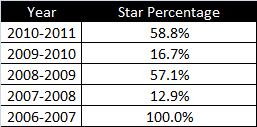After the first weekend of the playoffs, I wrote a post about the astonishing 0.700 combined FTA/FGA ratio posted by Kevin Durant, Kobe Bryant, LeBron James, Derrick Rose, Chris Paul, Dirk Nowitzki and Dwight Howard. Not surprisingly, that number has come down over the past week. However, it hasn’t dropped as much as you’d expect. After four (or five) playoff games, that septet’s FTA/FGA ratio has fallen to 0.635.
In general, more fouls are called in the playoffs, which means more free throw attempts, which means that ratio will rise league-wide. In last week’s post we found that star players tend to create a much greater share of that change then your average player. This year we found that the FTA/FGA ratio had risen 0.068, from 0.300 in the regular season, 0.368 in the playoffs. We also found that if we removed the field goal and free throw attempts of those seven players, the increase was only 0.028, meaning this group was responsible for 58.8% of the increase.
A comment on that first post asked me to provide updated numbers to see if the pattern is holding steady. It certainly is. This table shows the FTA/FGA change from the regular season to the playoffs in each of the last 5 years.
This table shows the same numbers but with the seven top MVP vote getters removed. (For this season, it’s the Durant, Kobe, LeBron, Rose, Paul, Nowitzki, Howard group we already identified.)
This table shows the percentage of the change which can be traced to the contributions of those seven players we removed.
Although the league-wide gap between the FTA/FGA ratio in the regular season and playoffs has narrowed, our seven stars are actual responsible for a great share of the change than they were just a week ago.
It’s very probable that this pattern won’t hold past the first round, mostly because of the way I’ve calculated it. I’m removing the total contributions of those seven players from the total numbers, league-wide. Either Kobe or Paul will be eliminated, possibly with Dwight Howard joining them. As those players check out of the playoffs the league-wide totals will continue to grow without their contributions. Part of the reason the percentages were so low in 2010 and 2008 is because several of the MVP candidates were knocked out of the playoffs early on. My guess is that if the numbers were run on a round-by-round basis we would see consistent percentages closer to the 50% range.
There are plenty of possible reasons for this pattern, some reasonable, some slightly disconcerting. Whatever the reason, there can be no question that stars get more calls in the playoffs than their less-accomplished counterparts.








